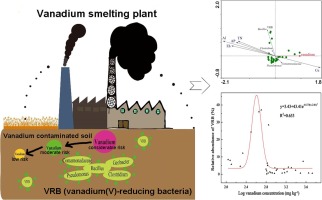Environment International ( IF 10.3 ) Pub Date : 2020-03-09 , DOI: 10.1016/j.envint.2020.105630 Song Wang , Baogang Zhang , Tingting Li , Zongyan Li , Jie Fu

|
The mining and smelting of navajoite has resulted in a serious vanadium pollution in regional geological environments and significant influence on soil microorganisms. However, the core microbiome responsible for adjusting community response to vanadium pollution and the driving pattern have been kept unclear. In this study, a suite of surface and profile soil samples over multiple gradients were collected in four directions and distances of 10–2000 m from a vanadium smelting plant in Panzhihua, China. The indigenous microbial communities and vanadium(V)-reducing related bacteria (VRB) were profiled by 16S rRNA gene high-throughput sequencing technique. Five VRB were detected in the original collected soil samples including Bacillus, Geobacter, Clostridium, Pseudomonas and Comamonadaceae based on high-throughput sequencing data analysis, and their abundances were significantly related with the content of vanadium. Low vanadium concentration promoted the growth of VRB, while high vanadium concentration would inhibit VRB multiplication. The Gaussian equation could be used to quantitatively describe the nonlinear relationship between VRB and vanadium. Network analysis demonstrated that the microbial communities were significantly influenced by VRB assemblage, and 1.32–52.77% of microbes in the community showed a close association with VRB. A laboratory incubation experiment also confirmed the core role of VRB to drive community response to vanadium pressure.







































 京公网安备 11010802027423号
京公网安备 11010802027423号